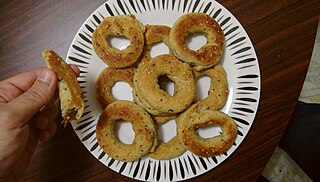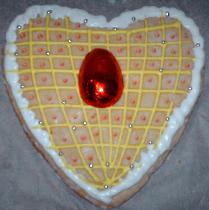
Confectionery is the art of making confections, which are food items that are rich in sugar and carbohydrates. Exact definitions are difficult. In general, however, confectionery is divided into two broad and somewhat overlapping categories: bakers' confections and sugar confections. The occupation of confectioner encompasses the categories of cooking performed by both the French patissier and the confiseur.

Cake is a flour confection made from flour, sugar, and other ingredients and is usually baked. In their oldest forms, cakes were modifications of bread, but cakes now cover a wide range of preparations that can be simple or elaborate and which share features with desserts such as pastries, meringues, custards, and pies.

Marzipan is a confection consisting primarily of sugar and almond meal, sometimes augmented with almond oil or extract.

Icing, or frosting, is a sweet, often creamy glaze made of sugar with a liquid, such as water or milk, that is often enriched with ingredients like butter, egg whites, cream cheese, or flavorings. It is used to coat or decorate baked goods, such as cakes. When it is used between layers of cake it is known as a filling.
Maltese cuisine reflects Maltese history; it shows strong Italian influences as well as influences from Spanish, French, Provençal, and other Mediterranean cuisines, with some later British culinary influence. Having to import most of its foodstuffs, being positioned along important trade routes, and having to cater for the resident foreign powers who ruled the islands opened Maltese cuisine to outside influences. The traditional Maltese stewed rabbit is often identified as the national dish.

Ukrainian cuisine is the collection of the various cooking traditions of the people of Ukraine, one of the largest and most populous European countries. It is heavily influenced by the rich dark soil (chornozem) from which its ingredients come, and often involves many components. Traditional Ukrainian dishes often experience a complex heating process – "at first they are fried or boiled, and then stewed or baked. This is the most distinctive feature of Ukrainian cuisine".

A hamantash is an Ashkenazi Jewish triangular filled-pocket pastry associated with the Jewish holiday of Purim. The name refers to Haman, the villain in the Purim story. In Hebrew, hamantashen are also known as אוזני המן, meaning "Haman's ears". "Haman's ears" also refers to a Sephardic Purim pastry, "Orejas de Haman", thought to originate in Spain and Italy, that is made by frying twisted or rolled strips of dough.

A macaron or French macaroon is a sweet meringue-based confection made with egg white, icing sugar, granulated sugar, almond meal, and often food colouring.

Almond paste is made from ground almonds or almond meal and sugar in equal quantities, with small amounts of cooking oil, beaten eggs, heavy cream or corn syrup added as a binder. It is similar to marzipan, but has a coarser texture. Almond paste is used as a filling in pastries, but it can also be found in chocolates. In commercially manufactured almond paste, ground apricot or peach kernels are sometimes added to keep the cost down.

Kue is a Southeast Asian bite-sized snack or dessert, especially in Brunei, Indonesia, Malaysia and Singapore. Kue or kuih are fairly broad terms in the Malay archipelago to describe a wide variety of snacks including cakes, cookies, fritters, pies, scones, and patisserie. Kue are made from a variety of ingredients in various forms; some are steamed, fried or baked. They are popular snacks in the Malay archipelago, which has the largest variety of kue. Because of the archipelago's historical colonial ties, Koeé (kue) is also popular in the Netherlands.

Ka'ak or kahqa is the common Arabic word for cake or biscuit, in its various senses, and can refer to several different types of baked goods produced throughout the Arab world and the Near East. The bread, in Middle Eastern countries, is similar to a dry and hardened biscuit and mostly ring-shaped. Similar pastry, called "kue kaak", is also popular in Indonesia.
Ciambella is an Italian ring-shaped cake with regional varieties in ingredients and preparation. As an example, a basic version of the cake could be prepared using flour, baking powder, salt, eggs, milk, sugar, oil and vanilla flavoring. Honey is sometimes added as a sweetener. To create the light texture the sugar and eggs are whisked together, and oil and milk are added while whisking continuously until the mixture is frothy. Then sifted baking powder and flour are added to the dry ingredients and the cake is baked in a ring shaped pan.

Sponge cake is a light cake made with eggs, flour and sugar, sometimes leavened with baking powder. Some sponge cakes do not contain egg yolks, like angel food cake, but most of them do. Sponge cakes, leavened with beaten eggs, originated during the Renaissance, possibly in Spain. The sponge cake is thought to be one of the first non-yeasted cakes, and the earliest attested sponge cake recipe in English is found in a book by the English poet Gervase Markham, The English Huswife, Containing the Inward and Outward Virtues Which Ought to Be in a Complete Woman (1615). Still, the cake was much more like a cracker: thin and crispy. Sponge cakes became the cake recognised today when bakers started using beaten eggs as a rising agent in the mid-18th century. The Victorian creation of baking powder by English food manufacturer Alfred Bird in 1843 allowed the addition of butter to the traditional sponge recipe, resulting in the creation of the Victoria sponge. Cakes are available in many flavours and have many recipes as well. Sponge cakes have become snack cakes via the Twinkie.

A kwarezimal is a traditional Maltese biscuit, usually baked during Lent. It contains flour, sugar, orange rind and ground almonds. They are vegan, since they contain no animal protein, eggs, or dairy products.

A pasticciotto is a type of filled Italian pastry. Depending on the region, they are traditionally filled with either ricotta cheese or egg custard. In some Italian-American communities, they are called pusties.













